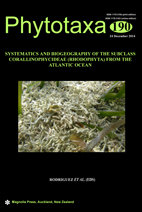Abstract
The name Mesophyllum erubescens has been applied to protuberant rhodolith specimens which sometimes occur abundantly, as well as to encrusting specimens in tropical and temperate waters in the Western Pacific, Indian and Western Atlantic Oceans. A DNA sequence, representing about 20% of the rbcL gene, was obtained from the 140 year old holotype specimen collected in the Fernando de Noronha Archipelago by the Challenger Expedition. This sequence was identical to field-collected topotype specimens as well as to specimens ranging south along the coast of Brazil. Sequences for psbA from these same Brazilian specimens and specimens from the east coast of Mexico were identical or differed by 1 base pair. In contrast, specimens called M. erubescens based on morpho-anatomical characters in the Pacific Ocean differed from Western Atlantic Ocean specimens by 2.5–13.1%, indicating that these represent numerous distinct species. All reports of non-geniculate coralline species said to be widely distributed across different oceans or in different biogeographic provinces based on morpho-anatomical characters need to be verified by DNA sequences.

